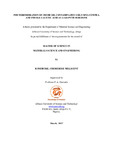Browsing by Title
Now showing items 3198-3217 of 4806
-
Photometric Stereo
(1978-06-01)Traditional stereo techniques determine range by relating two images of an object viewed from different directions. If the correspondence between picture elements is known, then distance to the object can be calculated ...
-
Physiology and Psychology of Color Vision -- A Review
(1976-08-01)This paper is a review of the anatomy, physiology, and psychology of human color vision.
-
Phytoremediation of Crude Oil Contaminated Soil Using Cowpea and Indole-3-Acetic Acid as a Growth Hormone
(2017-03-22)One of the unintended impacts of crude oil exploration is the pollution of agricultural land and aquatic resources when there is accidental oil spillage. The environmental effect of this has resulted in untold hardship to ...
-
Pi: A Parallel Architecture Interface for Multi-Model Execution
(1990-05-01)This thesis defines Pi, a parallel architecture interface that separates model and machine issues, allowing them to be addressed independently. This provides greater flexibility for both the model and machine builder. ...
-
Picking Parts out of a Bin
(1983-10-01)One of the remaining obstacles to the widespread application of industrial robots is their inability to deal with parts that are not precisely positioned. In the case of manual assembly, components are often presented ...
-
Picking Up an Object from a Pile of Objects
(1983-05-01)This paper describes a hand-eye system we developed to perform the binpicking task. Two basic tools are employed: the photometric stereo method and the extended Gaussian image. The photometric stereo method generates ...
-
PICPAC: A PDP-6 Picture Package
(1967-10-01)PICPAC is a program to be used for manipulating pictures of real-world scenes. It operated under ITS (the Incompatible Time-Sharing System) under control of a simple on-line command language. It includes facilities for ...
-
Piecemeal Learning of an Unknown Environment
(1994-03-01)We introduce a new learning problem: learning a graph by piecemeal search, in which the learner must return every so often to its starting point (for refueling, say). We present two linear-time piecemeal-search ...
-
Piezoelectric Micromotors for Microrobots
(1991-02-01)By combining new robot control systems with piezoelectric motors and micromechanics, we propose creating micromechanical systems which are small, cheap and completely autonomous. We have fabricated small - a few ...
-
Piezoelectric Ultrasonic Micromotors
(1995-06-01)This report describes development of micro-fabricated piezoelectric ultrasonic motors and bulk-ceramic piezoelectric ultrasonic motors. Ultrasonic motors offer the advantage of low speed, high torque operation without ...
-
PIKA: A Network Service for Multikernel Operating Systems
(2014-01-28)PIKA is a network stack designed for multikernel operating systems that target potential future architectures lacking cache-coherent shared memory but supporting message passing. PIKA splits the network stack into several ...
-
PILOT: A Step Toward Man-Computer Symbiosis
(1966-09-01)PILOT is a programming system constructed in LISP. It is designed to facilitate the development of programs by easing the familiar sequence: write some code, run the program, make some changes, write some more code, ...
-
Plain Talk About Neurodevelopmental Epistemology
(1977-06-01)This paper is based on a theory being devloped in collaboration with Seymour Papert in which we view the mind as an organized society of intercommunicating "agents". Each such agent is, by itself, very simple. The ...
-
A Plan for Optimizing Network-Intensive Cloud Applications
(2013-02-12)A significant and growing number of applications deployed on cloud infrastructures are network-intensive. These applications are frequently bottlenecked by the speed of network connections between the machines on which ...
-
Plan Recognition in a Programmer's Apprentice
(MIT Artificial Intelligence Laboratory, 1977-05)Brief Statement of the Problem: Stated most generally, the proposed research is concerned with understanding and representing the teleological structure of engineered devices. More specifically, I propose to study the ...
-
Plan Verification in a Programmer's Apprentice
(MIT Artificial Intelligence Laboratory, 1978-01)Brief Statement of the Problem: An interactive programming environment called the Programmer's Apprentice is described. Intended for use by the expert programmer in the process of program design and maintenance, the ...
-
Plan-Driven Pervasive Computing
(2006-03-01)The goal of human-centered, pervasive computing should be to hide the details of the computing environment, allowing users to concentrate on their goals, rather than on the direct management of devices. This paper describes ...
-
Plan-view Trajectory Estimation with Dense Stereo Background Models
(2001-02-01)In a known environment, objects may be tracked in multiple views using a set of back-ground models. Stereo-based models can be illumination-invariant, but often have undefined values which inevitably lead to foreground ...
-
Planck intermediate results: LI. Features in the cosmic microwave background temperature power spectrum and shifts in cosmological parameters
The six parameters of the standard ΛCDM model have best-fit values derived from the Planck temperature power spectrum that are shifted somewhat from the best-fit values derived from WMAP data. These shifts are driven by ...
-
Plane Geometry Theorem Proving Using Forward Chaining
(1974-01-01)A computer program is described which operates on a subset of plane geometry. Its performance not only compares favorably with previous computer programs, but within its limited problem domain (e.g. no curved lines ...

